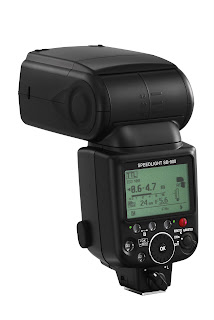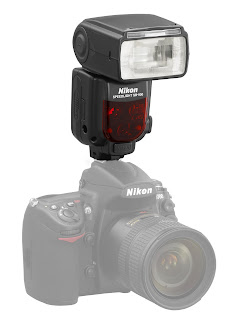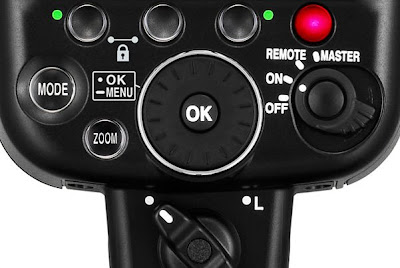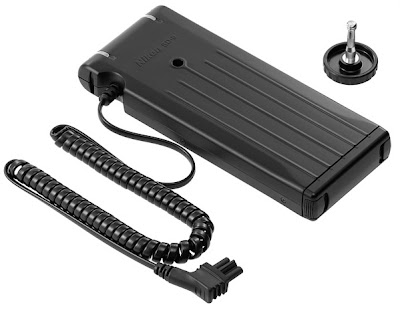 UPDATE: SB-900 full review now posted.
UPDATE: SB-900 full review now posted.Nikon has just announced a new flash: The Nikon SB-900 speedlight. From what I can see, it is quite a departure from the Nikon SB-800, and the feature list is as long as the price tag is big. Much more, after the jump.
Highlights:
• Rotates 180 degrees right or left. Sweet.
• Flash tube overheat protection, great for hi-power battery users
•
• Faster recycling - 4 secs w/Alkaline, 2.3 secs w/NiMH batts
• Tighter beam spread - up to 200mm throw
• Beam shaping - custom light patterns within the beam
• Faster CLS adjustments - physical dials.
• Upgradable firmware - sweet.
• One-second recycle w/new SD-9 Battery pack.
• Flash duration times: 1/880 (@full power) to 1/38,500 (@ 1/128 power)
• Has SU-4 setting, which presumably still means a great manual slave.
• It's a real honker. Ryan Brenizer has an animated .gif swapping out with the SB-800 here.
and...
It's five hundred smackers.
______________
 I will probably get one, but I will definitely still be based on SB-800's for a while.
I will probably get one, but I will definitely still be based on SB-800's for a while. In fact, this may well drive down the price of SB-800s. Not so much at retail -- Nikon has their price points distributed pretty well for the '600, '800 and '900. But there will be a lot of people who will unload '800's into the market when they get their new '900. (I mean, who needs more than one flash, right?)
And yes, this is probably the only photo site that cares more about the new strobe than the new D-700. If anyone gets hands-on time, please report in via the comments. Thanks!
More info at Nikon site.
_______________
Full Press Release Text
NEW NIKON SB-900 SPEEDLIGHT ADVANCES FLASH TECHNOLOGY AT THE SPEED OF LIGHT WITH EXPANSIVE ZOOM AND INTELLIGENT FEATURES
Nikon’s Newest Flagship Speedlight Offers a Powerful Addition to the Versatile Nikon Creative Lighting System (CLS)
MELVILLE, N.Y. (July 1, 2008) – Nikon, Inc. today introduced the SB-900 Speedlight to provide Nikon digital SLR photographers with a flash capable of a wide zoom range, increased versatility, faster recycling time, and a wealth of intelligent features to enhance the already vast functionality of the Nikon Creative Lighting System (CLS). Building on the success of the popular SB-800 Speedlight, the SB-900 provides users with extensive creative lighting possibilities with a simplified interface and the ability to stay up to date with future technologies through user-applied firmware updates.*
The SB-900 offers unprecedented zoom range coverage from 17 to 200mm, to increase flexibility in a variety of shooting conditions, while automatically adapting itself to Nikon’s FX or DX-format cameras. Additionally, light output has been increased to a maximum guide number of 48/157.5 (ISO 200, meters/feet at 35mm FX-format and Standard). Photographers can now also select from three light patterns; “Center-weighted” provides the highest guide number and is suitable for images such as portraits, where light falloff at the image edges is of less importance. “Standard” provides a familiar pattern, similar to the SB-800, and is ideal for general photography and “Even” which delivers the most consistent edge-to-edge coverage, making it ideal for situations such as group photography. Additionally, Nikon’s newest flagship Speedlight provides photographers with advanced wireless i-TTL capabilities allowing the utilization of multiple Speedlights with ease and confidence on location or in the studio.
“Nikon is proud that its innovative leadership in flash technologies has been praised by photographers who have realized the versatility and power that the Nikon Creative Lighting System contributes to their photography,” said Edward Fasano, general manager for marketing, SLR System Products at Nikon, Inc. “The SB-900 Speedlight now provides photographers with a new level of portable lighting functionality, with performance and intelligent features that adapt to an even wider scope of lighting challenges.”
The SB-900 Speedlight is engineered to address the creative lighting challenges faced by today’s photographers including a need for fast, on-demand performance, and the ability to adapt seamlessly to nearly any lighting scenario. The SB-900’s innovative design has the Xenon flash tube and reflector system moving independently – allowing for a wider zoom range from an extreme wide angle of 17mm (FX) to the telephoto setting which reaches 200mm without the aid of accessories or as wide as 12mm in DX mode with the built-in wide-angle panel engaged.
The SB-900 offers a quick recycle time of 4.0 seconds (at full power) with four Alkaline AA batteries which drops to a mere 2.3 seconds (at full power) while using four rechargeable NiMH batteries—about 25 percent faster than the SB-800 with its fifth battery attachment.

While ease of use has always been a defining hallmark of the Nikon CLS System, the user interface has been even further refined to simplify control and offer faster operation. Controls for setting the wireless Master and Remote have been relocated to the outside of the unit for easier access and frequently used functions are easily adjusted with a new Rotary Select Dial. A larger LCD screen is easy to read, even in direct sunlight, and photographers can assign “My Menu” hotkeys for quicker access to commonly used functions. A new thermal cut-out protection system monitors conditions when the flash might overheat due to excessive rapid bursts. Helpful operating temperature information is provided to the photographer with an innovative temperature gauge displayed on the LCD screen.
For the first time, Nikon SB-900 Speedlight users will have the ability to take advantage of future performance advancements, by way of user-uploadable firmware. The user will be able to download the firmware onto a flash media card and upload it to the flash through select digital SLR cameras.*
The SB-900 Speedlight is Nikon’s most intelligent Speedlight ever, created in response to the needs of today’s digital photographic professionals. When using the included fluorescent or incandescent filters and adaptor, the flash automatically recognizes what filter is being used and automatically adjusts white balance accordingly on the latest Nikon D-SLRs.* Additionally, the SB-900 aids auto focus with a broader AF assist beam that covers a wide 20-105mm that is matched to all of the D3, D700 and D300’s 51 focus points. The bounce and swivel capability of the SB-900 has been expanded to include: tilt up to 90 degrees, down minus 11 degrees, and a full 180-degree swivel left or right, allowing more creativity for on or off camera use, or as a remote Speedlight.
The SB-900 serves as the new core for the Nikon Creative Lighting System when used in combination with Nikon SLRs, and supports Advanced Wireless Lighting as a master or a remote Speedlight, inviting photographers to discover endless creative possibilities. While using one or more Nikon Speedlights wirelessly, photographers can artistically use shadows, highlight details, and light complicated angles with ease. Along with the SB-900, the Nikon Creative Lighting System features a comprehensive assortment of personal lighting tools that include the agile SB-600 and SB-400, and the remarkable R1 and R1C1 Wireless Close-up Speedlight systems.
Available accessories

The SD9 Battery Pack boosts flash recycle time to a mere one second (at full power). For faster recycling or all-day shooting it accepts up to eight AA batteries. To enhance the weatherproof ability of Nikon D-SLRs, optional Water Guards will be available for select cameras to protect the connection between the flash and camera, allowing users to utilize the flash when weather conditions are less than ideal.
Price and availability
The new Nikon SB-900 Speedlight is scheduled to be available in August 2008, and will have an estimated selling price of $499.95.** The SB-900 will come packaged with the Speedlight Stand, Bounce Adapter, Color Filter Holder, Intelligent Color Filter Kit, Diffuser Dome and the Soft Case. The SD9 Battery Pack is also scheduled to be available in August 2008 with an estimated selling price of $230.00.
About Nikon
Nikon, At the Heart of the Image™. Nikon Inc. is the world leader in digital imaging, precision optics and photo imaging technology and is globally recognized for setting new standards in product design and performance for its award-winning consumer and professional photographic equipment. Nikon Inc. distributes consumer and professional digital SLR cameras, NIKKOR optics, Speedlights and system accessories; Nikon COOLPIX® compact digital cameras; COOLSCAN® digital film scanners; 35mm film SLR cameras; Nikon software products and Nikon sports and recreational optics. Nikon D Series digital SLR cameras are recognized as “Highest in Customer Satisfaction with digital SLR cameras,” according to the latest J.D. Power and Associates 2007 digital Camera Satisfaction Study. Nikon Corporation, the parent company of Nikon Inc., recently celebrated its 90th anniversary and announced the production of over 40 million NIKKOR SLR interchangeable lenses. For more information, dial (800) NIKON-UX or visit http://www.nikonusa.com, which links all levels of photographers to the Web's most comprehensive photo learning and sharing communities.
# # #
For J.D. Power and Associates award information go to jdpower.com
* With D3 and D700 Cameras only
** Estimated selling price listed is only an estimate. Actual prices are set by dealers and are subject to change at any time.





















